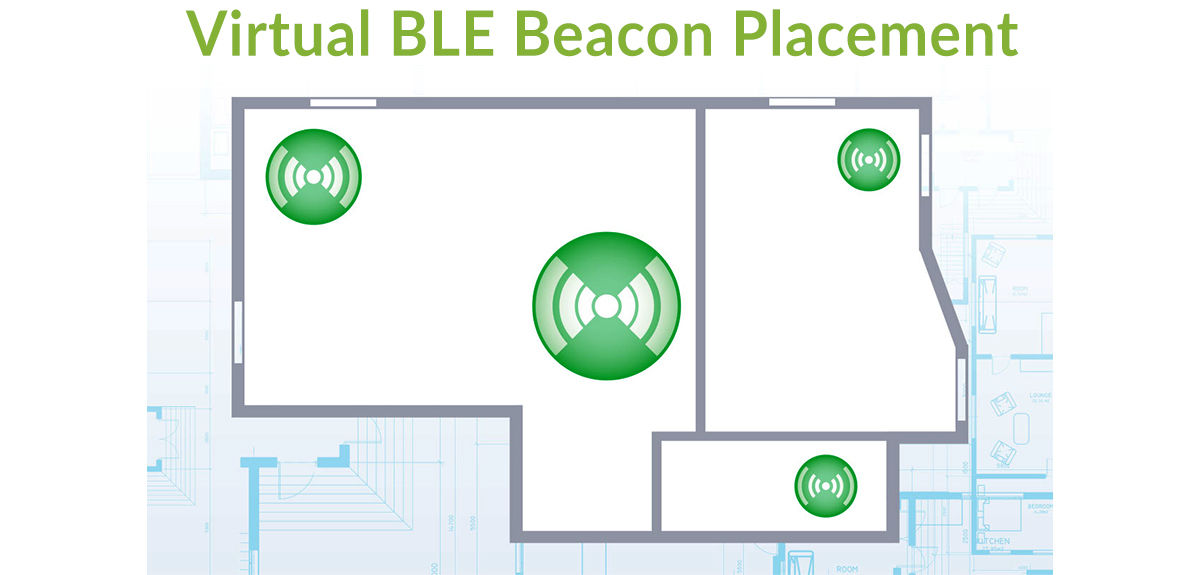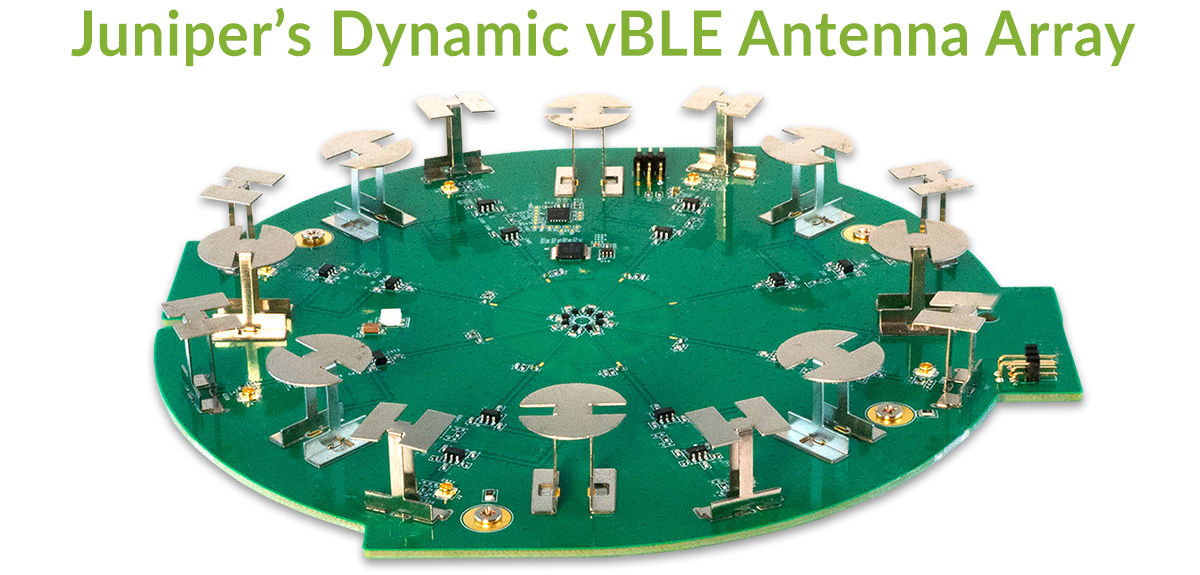What is virtual Bluetooth LE (vBLE) technology?
What is virtual Bluetooth LE (vBLE) technology?
To understand vBLE, it helps to first understand Bluetooth® and Bluetooth® Low Energy (BLE) technologies. Bluetooth is a wireless communications technology used primarily for connecting devices with each other over short distances. For example, it allows wireless headsets, keyboards, mice, and hands-free systems to communicate with smart phones and computers. Like Bluetooth and Wi-Fi, BLE operates in the 2.4 GHz band, connecting devices to form a personal-area network. However, BLE uses low power, remaining in sleep mode unless a connection is initiated.
Virtual Bluetooth LE (vBLE) builds on BLE. It’s a patented technology for indoor location-based services that uses virtual beacons rather than physical beacons to more precisely and affordably locate devices containing BLE sensors. vBLE achieves this with a patented 16-element directional antenna array, which sends unique RF energy in multiple directions. vBLE signals emanating from a vBLE-enabled Wi-Fi or Bluetooth access point eliminate the need for physically mounted, battery-powered BLE beacons throughout a site. Instead, location service applications use data gathered by the virtualized BLE beacons and an AI/ML engine to calculate mobile device locations with a very high degree of accuracy.
In this way, vBLE enables businesses to cost-effectively deliver real-time location-based experiences to customers and employees that are engaging, accurate, and scalable.
What problem(s) does vBLE solve?
vBLE overcomes cost and operational challenges associated with deploying large physical BLE networks. Traditional beaconing technology requires installing large volumes of battery-powered devices (transmitters), which create the following IT burdens:
- Comprehensive site surveys are required to arrange and calibrate beacons for optimum performance and accuracy in each environment. This is necessary both upon initial deployment and on an ongoing basis, in that any change to the environment requires a new site survey and recalibration. The reason is that RF signals can be impacted by physical changes to the environment, such as new product displays, new or rearranged furniture, or even large influxes of people. In these situations, the location services system will be plagued by poor performance until the physical beacons can be recalibrated.
- High deployment costs. Many use cases require thousands of physical beacons in a single location for adequate coverage, which creates substantial cost barriers.
- Battery maintenance is problematic. While battery life has improved, a large enterprise may deploy tens of thousands of beacons, distributed across the globe. Locating and replacing dead batteries can become complex and difficult as the implementation grows.
- Physical beacons lack IP addresses. As such, they can’t be identified by the network and managed remotely by IT.
- Aesthetics. Battery-powered beacons are glued to the wall, often 25 feet apart. This can adversely impact the appearance of a location, which is often a nonstarter in hotels, museums, and other locations where aesthetics are important.
- Risk of theft and damage. Battery-powered beacons can be stolen or knocked off the wall, creating additional management headaches.
Virtual BLE addresses all these challenges with software-defined beaconing while delivering superior location experiences to users and customers.
What are vBLE’s main benefits?
Virtualized wireless beaconing technology allows continuous, real-time, and scalable mobile location calculations, providing the following benefits to businesses that deploy it:
- Optimum accuracy precision for locating BLE-enabled devices
- Improved user experiences with location services, such as real-time wayfinding, asset tracking, and proximity messaging/marketing
- Increased efficiencies and revenue from improved allocation and management of people and assets throughout a facility
How does vBLE work?
A patented technology owned by Juniper Networks, vBLE works by adding virtual beacons to existing Wi-Fi or standalone Bluetooth networks, eliminating the need for physical beacons with batteries.
The following components make up vBLE:
- 16-antenna vBLE array. Dynamic 16-antenna vBLE arrays in Juniper Wi-Fi and Bluetooth APs cover an entire room with BLE signals, ensuring maximum scalability with minimal investment.
- AI/ML. Juniper APs continuously collect and analyze data in real-time from all mobile devices to ensure accurate location estimates and eliminate the need for manual and time-consuming site surveys and calibrations.
- Virtual beacons. Patented vBLE lets you deploy and move virtual beacons with the simple click of a mouse (or via APIs), rather than physically installing and moving beaconing equipment. This delivers a more scalable and cost-effective solution for infusing location context into your wireless deployment.
- Programmable SDK. vBLE is 100% programmable with Juniper’s mobile SDK, which offers open APIs for full automation and/or seamless integration with complementary products.

vBLE beacons (green) identify locations on a facility layout, enabling location functionality by associating locations with BLE-enabled assets and personnel. By enabling highly accurate, real-time location capabilities, vBLE enhances user location-based experiences.

The 16-element vBLE antenna array resides in Juniper Wi-Fi and Bluetooth access points, providing device/sensor location accuracy of less than three meters.
How Juniper implements vBLE
Juniper’s vBLE array technology is enabled in our Wi-Fi and Bluetooth access points with a patented 16-element directional antenna array to power indoor location services. In addition, Juniper Indoor Location Services leverage Juniper vBLE array technology and cloud-based ML to drive down the cost of deployment and improve the accuracy of real-time indoor location services, from wayfinding to location-based proximity notifications. Businesses can easily engage mobile users without the need for more expensive Wi-Fi services or battery-powered physical Bluetooth beacons.
vBLE FAQs
What is a vBLE beacon?
A vBLE beacon is a software-represented Bluetooth Low Energy (BLE) beacon that helps optimize location service accuracy. With Juniper’s patented vBLE technology, no battery-powered beacons or manual calibration are required to implement indoor location services. You can quickly deploy an unlimited number of virtual beacons with ease.
How do vBLE beacons change the indoor mobile experience?
vBLE beacons eliminate the need to install physical beacons and all their support requirements, including battery replacement. This allows businesses to remotely place and move virtual beacons at will using the Juniper Mist cloud user interface or programmable APIs, enabling more accurate and timely location services and user experiences.
Who is looking to implement vBLE technology?
vBLE is of most interest to businesses that wish to implement asset tracking, deploy user engagement services, and enhance wireless experiences in their user and customer environments without the cost and operational burden of physically installing and maintaining fixed, battery-powered BLE beacons.
What vBLE technology solutions does Juniper offer?
Juniper offers a wide portfolio of Wi-Fi and Bluetooth® access points for the enterprise with integrated vBLE virtual beaconing that enables the deployment of highly accurate indoor location services. Businesses can use our vBLE-enabled solutions to easily engage mobile users without the need for battery-powered Bluetooth beacons, site surveys, and recalibration burdens.
For example, Juniper Mist User Engagement and Asset Visibility subscription services leverage vBLE, Wi-Fi, and AI/ML technology to calculate and provide accurate device location information to external tools and software through easy-to-use open and programmable APIs.


